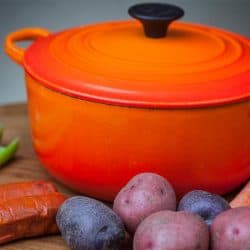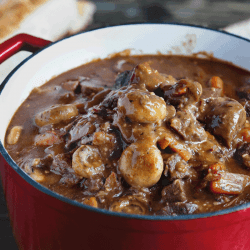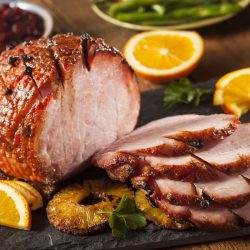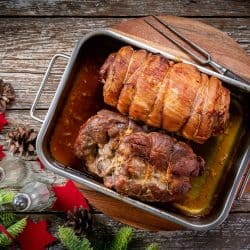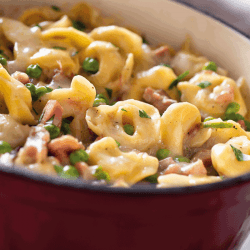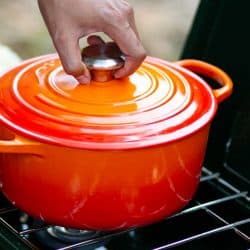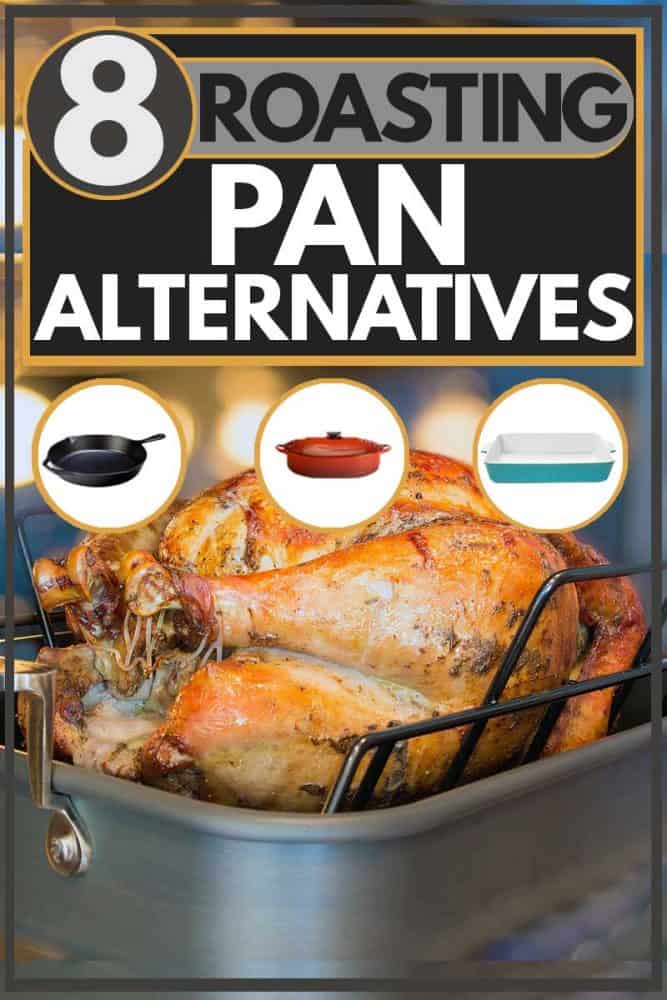 Roasting is a simple, dry cooking method that involves evenly circulating hot air around meat, fish, or vegetables. If roasting conjures up images of hauling out a cumbersome, holiday roasting pan, don’t worry! Your fully equipped kitchen already has a roasting pan alternative that you can easily store and use regularly.
Roasting is a simple, dry cooking method that involves evenly circulating hot air around meat, fish, or vegetables. If roasting conjures up images of hauling out a cumbersome, holiday roasting pan, don’t worry! Your fully equipped kitchen already has a roasting pan alternative that you can easily store and use regularly.
We’ve found 8, handy roasting pan alternatives for you to use the next time you want to roast a healthy, delicious meal:
- Cast Iron Skillet
- Dutch Oven
- Rimmed Sheet Pan
- Casserole/Baking Dish (Bakeware)
- Braising Pan
- Broiler Pan
- Grill
- Roasting Rack
Keep reading and, we’ll show you examples of each alternative pan along with a few tips to help your roast come out beautifully, golden brown, and delicious - no roasting pan needed!
How to Roast Without a Roasting Pan?
If you’ve ever fried an egg, baked a batch of cookies, or made a casserole odds are that your kitchen is fully equipped with one, or several of these roasting pan alternatives:
Cast Iron Skillet
A well-seasoned cast-iron skillet is a versatile addition to any kitchen. Capable of both stove-top and oven cooking, the cast iron skillet is an essential tool for sautéing, frying, searing, baking and roasting food. Cast iron skillets are available in a variety of sizes, between 3” and 12” diameters.
Click here to find this 12” Cast Iron Skillet by Lodge on Amazon.
Cast iron heats slowly but evenly. Low raised sides enable airflow around food during roasting. Used as a roasting pan, a cast-iron skillet can produce a luxuriously browned, fragile frittata or crisp, savory roast beef.
Dutch Oven
Dutch ovens were traditionally used to keep food moist and tender when slow-cooking over an open fire. An excellent stove-top and oven-safe tool for wet cooking, a Dutch oven conveniently prepares stews, soups, casseroles, brisket, chili, oatmeal, and even baked goods. But, you can also use a Dutch oven as a roasting pan alternative. Dutch ovens are available in a variety of shapes and sizes.
Click here to find this Dutch oven by Le Creuset on Amazon.
Made from either enameled cast iron or porcelain, Dutch ovens conduct heat evenly. High sides, however, minimize air circulation during roasting. To increase air circulation and achieve a browned finish on roasted meat or vegetables:
- Select an oval-shaped, versus a circular shaped Dutch oven.
- Remove the lid while roasting.
- Do not add other ingredients atop and along the sides of the Dutch oven.
- Insert a roasting rack.
Rimmed Sheet Pan
A large-sized sheet pan or cookie sheet with a rimmed edge is a simple alternative to use as a roasting pan. Most kitchens are equipped with these lightweight, easy to store pans commonly used for baking. Rimmed sheet pans are an excellent selection for roasting whole poultry, whole fish, or large portions of bone-in beef.
Click here to find this Rimmed Sheet Pan by Nordic Ware on Amazon.
Typically aluminum, sheet pans heat quickly. Low sides enable air to circulate the entire contents of the pan. You might want to line your sheet pan with aluminum foil to protect the non-stick surface of the pan from baked-on residue. Monitor your roast for drippings because shallow sheet pans can easily overflow.
Casserole/Baking Dish
No doubt, your kitchen is equipped with a casserole or baking dish. Bakeware is commonly used for cooking a meal, side-dish, or dessert that can be readily presented to the table straight from the oven. But, when you aren’t preparing lasagna, scalloped potatoes, macaroni and cheese, brownies, or cake, you can repurpose bakeware to be used for roasting.
Click here to find this Bakeware by KroKori on Amazon.
Casserole or baking dishes are available in a variety of shapes, sizes, and materials. Typically square or rectangular, we suggest using a versatile, larger size of 9” by 13” for roasting to accommodate a variety of foods. Made from ceramic, glass, metal, or silicone bakeware heats rapidly and evenly. Low sides enable air circulation during roasting. If your bakeware is equipped with an oven-safe lid, remove the cover to roast.
Braising Pan
Braising is a wet method of slow-cooking meat on the stove-top. A small amount of liquid is added to the braising pan allowing the meat to simmer at low heat, covered with a lid. But, braising pans are typically oven-safe, and with the lid removed, you can also use a braising pan for roasting.
Click here to find this Braising Pan by Anolon on Amazon.
Braising pans are circular in shape, wide, and have low edges. The design makes a good selection for roasting because, without the lid, the braising pan will promote air circulation around the food. Made from cast iron, enameled cast iron, metal, or porcelain braising pans tend to conduct heat evenly. But, the rate at which they warm might vary depending on the material.
Broiler Pan
Broiler pans are designed to cook meat, fish, or vegetables beneath intense, top-down heat. You might also use your broiler pan if you want to quickly melt cheese over an open-faced sandwich or brown the top of a sugary dessert. In a pinch, you can use a broiling pan to roast.
Click here to find this Broiler Pan by General Electric on Amazon.
Made from metal, ceramic, or enameled cast iron broiler pans heat quickly. Low sides promote air circulation around your roasting food. Large broiler pans can easily accommodate roasts but use caution to monitor the drippings because these shallow pans have little room to collect overflow.
Grill
If you are preparing a feast and your oven is already overloaded, consider using the grill to roast the main course. You can adjust the temperature of a gas grill to accommodate low, slow roasting or high heat for a quick, tender roast. If timing is not a concern, you can stoke a charcoal grill to prepare it for roasting with the bonus of a smokey finish.
Click here to find disposable roasting pans on Amazon.
We’d recommend using a disposable roasting pan for grilling your meat, fish, or vegetables. The aluminum pan will heat quickly, prevent your main course from falling through the grill grate, and hold onto the drippings for use in gravy. Keep the disposable roasting pan uncovered, and lift the lid of the grill occasionally to check the roast.
Roasting Rack
Adapt any of the pan alternatives mentioned above for roasting by inserting a roasting rack into the pan. Using a cooling rack, commonly used for baking, will also do the trick if it is the right size.
Click here to find this Roasting Rack by Granite Ware on Amazon.
Click here to find this Cooling/Roasting Rack by Kitchenatics on Amazon.
A roasting rack will boost air circulation beneath the food, giving you an even roast. Roasting racks can be found in circular, oval, and also rectangular sizes to accommodate a variety of pans. They are made from several different materials, including metals, cast iron, or silicone.
Check out even more versatile ways to cook with your pots and pans at KitchenSeer.com
How to Cook a Ham Without a Roasting Pan?
Size-up an alternative roasting pan to fit your ham. Are you planning to roast a raw, fresh ham or ready-to-eat cured, cured and smoked, or pre-cooked spiral ham? No matter what type of ham you prefer, these simple guidelines ensure you’ll enjoy a fully cooked roast:
- Preheat the oven; roast at moderate heat of 325°F.
- Using a meat thermometer, determine any type of ham is fully cooked when the internal temperature reads 145°F.
- Check here for the USDA’s recommended timetable (minute/pound) for roasting ham.
- Allow the ham to rest for approximately 3 minutes before carving.
How to Cook a Turkey Without a Roasting Pan?
What about an alternative roasting pan to fit your turkey? If your pan choices are on the smaller side, remember, you can always roast your favorite portions of turkey rather than an entire bird. A turkey breast, or drumsticks, for example, will easily fit onto a smaller, alternative roasting pan to serve a savory meal.
Here are a few roasting tips to help you retrieve a golden, juicy bird from the oven:
- Preheat the oven; roast at moderate heat 325°F to 375°F.
- Using a meat thermometer, determine the turkey is fully cooked when the internal temperature reading is 165°F.
- Check here for the USDA’s recommended timetable (hour/pound) for roasting turkey.
- Allow the cooked turkey to rest for approximately 15 to 20 minutes before carving.
Now, all you’ll need is a good recipe for a tasty side-dish, and you’ll be well on your way toward roasting success.
Check out the latest roasting utensils at KitchenSeer.com.










